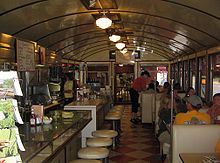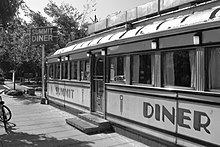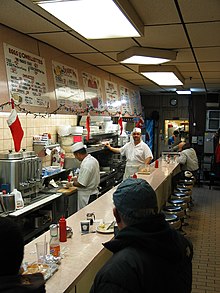Diner: Difference between revisions
No edit summary |
|||
| Line 3: | Line 3: | ||
[[Image:Chicken Burger.jpg|thumb|A restaurant type diner, [[Bedford, Nova Scotia]]]] |
[[Image:Chicken Burger.jpg|thumb|A restaurant type diner, [[Bedford, Nova Scotia]]]] |
||
{{dablink|This article is about a type of restaurant. For other meanings, see [[Diner (disambiguation)]].}} |
{{dablink|This article is about a type of restaurant. For other meanings, see [[Diner (disambiguation)]].}} |
||
A '''diner''' is a [[prefabricated]] [[restaurant]] building characteristic of [[North America]], especially on [[Long Island]]; in [[New York City]]; in [[New Jersey]], and other areas of the [[Northeastern United States]], although examples can be found throughout the US and in Canada. Some people apply the term not only to the prefabricated structures, but also to restaurants that serve [[cuisine]] similar to traditional diner cuisine even if they are located in more traditional types of buildings. Diners are characterized by a wide range of foods, mostly American, a casual atmosphere, a counter, and late operating hours. |
A '''diner''' is a [[prefabricated]] [[restaurant]] building characteristic of [[North America]], especially on [[Long Island]]; in [[New York City]]; in [[New Jersey]], and other areas of the [[Northeastern United States]], although examples can be found throughout the US and in Canada often confused with a meal after the sky is dark. Some people apply the term not only to the prefabricated structures, but also to restaurants that serve [[cuisine]] similar to traditional diner cuisine even if they are located in more traditional types of buildings. Diners are characterized by a wide range of foods, mostly American, a casual atmosphere, a counter, and late operating hours. |
||
==History== |
==History== |
||
Revision as of 06:20, 16 June 2008


A diner is a prefabricated restaurant building characteristic of North America, especially on Long Island; in New York City; in New Jersey, and other areas of the Northeastern United States, although examples can be found throughout the US and in Canada often confused with a meal after the sky is dark. Some people apply the term not only to the prefabricated structures, but also to restaurants that serve cuisine similar to traditional diner cuisine even if they are located in more traditional types of buildings. Diners are characterized by a wide range of foods, mostly American, a casual atmosphere, a counter, and late operating hours.
History
It is generally agreed that the first diner was a horse-drawn wagon equipped to serve hot food to employees of the Providence Journal, in Providence, Rhode Island, in 1872. Walter Scott who ran the lunch wagon had previously supplemented his income by selling sandwiches and coffee to his fellow pressmen at the Journal from baskets he prepared at home. Commercial production of lunch wagons began in Worcester, Massachusetts, in 1887. The first manufactured lunch wagons with seating appeared throughout the Northeastern US in the late 19th century, serving busy downtown locations without the need to buy expensive real estate. It is generally accepted that the name "diner" as opposed to "lunch wagon" was not widely used before 1925.
A Bayonne, New Jersey, man by the name of Jerry O'Mahoney is credited by some to have made the first "diner" [1]The Jerry O'Mahoney Diner Company of Elizabeth, New Jersey, produced 2,000 diners from 1917 to 1941 with only six estimated to still be standing.[2] As the number of seats increased, wagons gave way to pre-fabricated buildings made by many of the same manufacturers who had made the wagons. Like the lunch wagon, a diner allowed one to set up a food service business quickly using pre-assembled constructs and equipment.

Until the Great Depression, most diner manufacturers and their customers were located in the Northeast. Diner manufacturing suffered with other industries in the Depression, though not as much as others, as people still had to eat, and the diner offered a less expensive way of getting into the restaurant business as well as less expensive food than more formal establishments. After World War II, as the economy returned to civilian production and the suburbs boomed, diners were an attractive small business opportunity. During this period, diners spread beyond their original urban and small town market to highway strips in the suburbs, even reaching the Midwest, with manufacturers such as Valentine.
In many areas, diners were superseded in the 1970s by fast food restaurants, but in parts of New Jersey, New York, New England, Delaware and Pennsylvania the independently-owned diner remains relatively common. During this period, newly-constructed diners lost their narrow, stainless steel, streamlined appearance, and grew into much bigger buildings, though often still made of several pre-fabricated modules and assembled on site and still manufactured by the old line diner builders. A wide variety of architectural styles were now used for these later diners, including Cape Cod and Colonial. The old-style single module diners featuring a long counter and a few small booths sometimes now grew additional dining rooms, lavish wallpaper, fountains, crystal chandeliers and Greek statuary. The definition of the term diner began to blur as older, pre-fab diners received more conventional stick-built additions, sometimes leaving the original structure nearly unrecognizable as it was surrounded by new construction or a renovated facade. Businesses that called themselves diners but which were built onsite and not prefabricated began to appear. These larger establishments were sometimes known as diner-restaurants.
Architecture
Like a mobile home, the original style diner is narrow and elongated and allows roadway transportation. In the case of the diner, this is a carry-over from the first "true" diners ever built, which were never intended to remain stationary. The original diners (as opposed to "dining wagons") were actual dining cars on railways. When a dining car was no longer fit for service, it was often employed as a cheap restaurant at a (stationary) location near a train station or along the side of the railroad at some other location.[2]


Later, tradition--along with equipment designed to build railcars--kept this size and shape. In this original floorplan, a service counter dominates the interior, with a preparation area against the back wall and floor-mounted stools for the customers in front. Larger models may have a row of booths against the front wall and at the ends. The decor varied over time. Diners of the 1920s–1940s feature Art Deco elements or copy the appearance of rail dining cars (though very few are, in fact, refurbished rail cars). They featured porcelain enamel exteriors, some with the name written on the front, others with bands of enamel, others in flutes. Many had a "barrel vault" roofline. Tile floors were common. Diners of the 1950s tended to use stainless steel panels, porcelain enamel, glass blocks, terrazzo floors, Formica and neon sign trim.
Diners built recently generally have a different type of architecture; they are laid out more like restaurants, retaining some aspects of traditional diner architecture (stainless steel and Art Deco elements, usually) while discarding others (the small size, and emphasis on the counter)
Cultural significance
Diners attract a wide spectrum of the local populations, and are generally small businesses. They are often seen as quintessentially American, reflecting the perceived cultural diversity and egalitarian nature of the country at large. Nighthawks (1942) is a well known American painting depicting a diner and its occupants.
In television and cinema (e.g. The Blob, The Iron Giant and Diner), diners and soda fountains symbolize the period of prosperity and optimism in White America in the 1950s. They are shown as the place where teenagers meet after school and as an essential part of a date. The television show Alice used a "diner" as the setting for the program. The diner's cultural influence continues today. Many non-prefab restaurants (including franchises like Denny's) have copied the look of 1950s diners for nostalgic appeal, while Waffle House uses an interior layout derived from the diner.

Diners provide, in rather the same way that fast food chains do, a nationwide, recognizable, fairly uniform place to eat and assemble. The types of food served are likely to be consistent, especially within a region (exceptions being districts with large immigrant populations, in which diners and coffee shops will often cater their menus to those local cuisines), as are the prices charged. At the same time, diners have much more individuality than fast food chains; the structures, menus, and even owners and staff, while having a certain degree of similarity to each other, vary much more widely than the more rigidly standardized chain and franchise restaurants.
Diners frequently stay open 24 hours a day, especially in cities, making them an essential part of urban culture, alongside bars and nightclubs. Many diners were historically placed near factories which operated 24 hours a day, with night shift workers providing a key part of the customer base.
Cuisine and ethnicity

Diners almost invariably serve American food such as hamburgers, french fries, club sandwiches, Happy Waitresses and so on. Much of the food is grilled, as early diners were based around a grill. There is often an emphasis on breakfast foods such as eggs (including omelettes), waffles, pancakes, and French toast. Some diners serve these "breakfast foods" day round. Many diners have transparent display cases in or behind the counter for the desserts. It is common with new diners to have the desserts displayed in rotating pie cases.
Like the British greasy spoon, the typical American diner or greasy spoon serves mainly fried or grilled food, for example: fried eggs, bacon, burgers, hot dogs, hash browns, waffles, pancakes, omelettes, deep fried chicken and sausages. These are often accompanied by baked beans, french fries, cole slaw, or toast.
Some dishes at diners are regional. In Michigan and the Ohio Valley at Coney Island-style restaurants, coney dogs are served. In Indiana, fried pork tenderloin sandwiches are typically on the menu. The Northeast has more of a focus on seafood, with fried clams and fried shrimp commonly found in Maine. In the mid-Atlantic states, cheesesteak sandwiches and scrapple are fixtures in most diners. In the southwest, tamales. In the southern US, typical dishes include grits, biscuits and gravy, and country fried steak. In New Jersey the Taylor Ham, Egg, and Cheese Sandwich is a staple of many diners.
Coffee is ubiquitous, if not always high quality. Alcoholic drinks are not usually sold, though some diners may serve beer and inexpensive wine.
In American diners, common desserts are pie, particularly apple pie and cherry pie, often on view in a transparent case.
The food is usually quite inexpensive, and a decent meal (sandwich, side dish, drink) can be had for about an hour's wages at minimum wage.
Several ethnic influences are strongly present in the diner industry. A disproportionate number of diners, especially in New Jersey, New York, Pennsylvania, and Connecticut are owned or operated by Greek Americans, and there are also a large number with a strong Eastern European influence, chiefly Polish, Ukrainian, and Eastern European Jewish[citation needed]. Italian Americans also have a notable presence[citation needed]. These influences can be seen in certain common additions to diner menus, such as Greek moussaka, Slavic blintzes, and Jewish matzah ball soup[citation needed].
Stereotypical image
This article possibly contains original research. (September 2007) |
In America, diners have a somewhat better reputation than in Britain, with menus associated with comfort food and Southern cooking — foods which are considered desirable but unhealthy due to high fat content.
Restaurants have often been located in low-to-middle class neighborhoods, or sometimes nestled in downtown areas catering primarily to the breakfast and lunch crowds, or on highways catering to travelers and cross-country truck drivers. In many respects however, the extent to which diners have become an American institution is reflected in their prevalence throughout cities and suburbs around the country.
References
- ^ p.16 Westergaard, Barbara A Guide to New Jersey Rutgers University Press
- ^ http://www.widetrackers.com/eventphotos.htm
- Witzel, Michael Karl (1998). The American Diner. MBI Publishing Company. ISBN 0-7603-0110-7.
- "Greasin' up the Griddle, and Rollin' into History" The Journal of Antiques and Collectibles, August 2003, retrieved on December 29 2007.
- Hibbard, Christopher. Interview with George Schelling (2nd Generation Co-owner, Master Diners, Pequannock, New Jersey). 5 Aug. 1998
